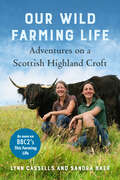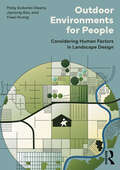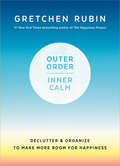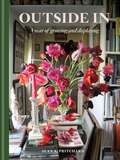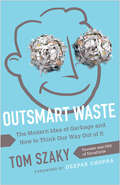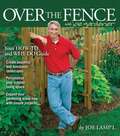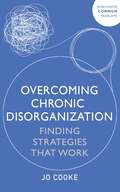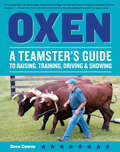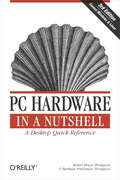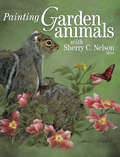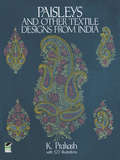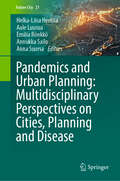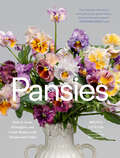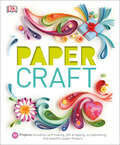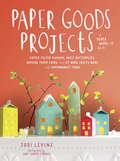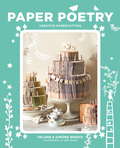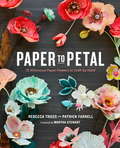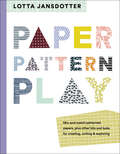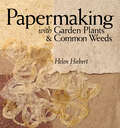- Table View
- List View
Our Wild Farming Life: Adventures on a Scottish Highland Croft
by Lynn Cassells Sandra BaerAs seen on the BBC’s This Farming Life The inspirational story of Lynbreck Croft—a regenerative Scottish farm rooted in local food, community, and the dreams of two women. "A ripping good account of the guts, luck and perseverance it takes to create a productive and healthy farm or croft that jumps the rails of our conventional industrial agriculture."—Nick Offerman, New York Times bestselling author of Where the Deer and the Antelope Play "I raced through this beautiful story with mounting awe and excitement. . . . Pragmatism, honesty and openness to new and old ideas shines through on every page. I hope it inspires legions of new farmers."—Isabella Tree, author of Wilding Lynn and Sandra left their friends, family, and jobs in England to travel north to Scotland to find a bit of land that they could call their own. They had in mind keeping a few chickens, a kitchen garden, and renting out some camping space; instead, they fell in love with Lynbreck Croft—150 acres of opportunity and beauty, shrouded by the Cairngorms and deep in the Highlands of Scotland. But they had no money, no plan, and no experience in farming. In Our Wild Farming Life, Lynn and Sandra recount their experiences as they rebuild their new home and work out what kind of farmers they want to be. They learn how to work with Highland cattle, become part of the crofting community and begin to truly understand how they can farm in harmony with nature to produce wonderful food for themselves and the people around them. Through efforts like these, Lynn and Sandra have been able to combine regenerative farming practices with old crofting traditions to keep their own personal values intact. Our Wild Farming Life is what happens when you follow your dreams of living on the land; a story of how two people became farmers—and how they learned to make a living from it, their way. "[This] is a warm yet realistic chronicle of the world of the small-time farmer, sharing a vision of how we humans can feed ourselves sustainably and ethically while living in harmony with the natural world."—Booklist "For anyone who has ever sat in a city office dreaming of . . . living off the land, this book will inspire them to take the plunge."—The Telegraph
Our Wild Farming Life: Adventures on a Scottish Highland Croft
by Lynn Cassells Sandra BaerAs seen on the BBC&’s This Farming LifeThe inspirational story of Lynbreck Croft—a regenerative Scottish farm rooted in local food, community, and the dreams of two women."A ripping good account of the guts, luck and perseverance it takes to create a productive and healthy farm or croft that jumps the rails of our conventional industrial agriculture."—Nick Offerman, New York Times bestselling author of Where the Deer and the Antelope Play"I raced through this beautiful story with mounting awe and excitement. . . . Pragmatism, honesty and openness to new and old ideas shines through on every page. I hope it inspires legions of new farmers."—Isabella Tree, author of WildingLynn and Sandra left their friends, family, and jobs in England to travel north to Scotland to find a bit of land that they could call their own. They had in mind keeping a few chickens, a kitchen garden, and renting out some camping space; instead, they fell in love with Lynbreck Croft—150 acres of opportunity and beauty, shrouded by the Cairngorms and deep in the Highlands of Scotland.But they had no money, no plan, and no experience in farming.In Our Wild Farming Life, Lynn and Sandra recount their experiences as they rebuild their new home and work out what kind of farmers they want to be. They learn how to work with Highland cattle, become part of the crofting community and begin to truly understand how they can farm in harmony with nature to produce wonderful food for themselves and the people around them. Through efforts like these, Lynn and Sandra have been able to combine regenerative farming practices with old crofting traditions to keep their own personal values intact.Our Wild Farming Life is what happens when you follow your dreams of living on the land; a story of how two people became farmers—and how they learned to make a living from it, their way."[This] is a warm yet realistic chronicle of the world of the small-time farmer, sharing a vision of how we humans can feed ourselves sustainably and ethically while living in harmony with the natural world."—Booklist"For anyone who has ever sat in a city office dreaming of . . . living off the land, this book will inspire them to take the plunge."—The Telegraph
Outdoor Environments for People: Considering Human Factors in Landscape Design
by Patsy Eubanks Owens Jayoung Koo Yiwei HuangOutdoor Environments for People addresses the everyday human behavior in outdoor built environments and explains how designers can learn about and incorporate their knowledge into places they help to create. Bridging research and practice, and drawing from disciplines such as environmental psychology, cultural geography, and sociology, the book provides an overview of theories, such as personal space, territoriality, privacy, and place attachment, that are explored in the context of outdoor environments and, in particular, the landscape architecture profession. Authors share the impact that place design can have on individuals and communities with regard to health, safety, and belonging. Beautifully designed and highly illustrated in full color, this book presents analysis, community engagement, and design processes for understanding and incorporating the social and psychological influences of an environment and discusses examples of outdoor place design that skillfully respond to human factors. As a textbook for landscape architecture students and a reference for practitioners, it includes chapters addressing different realms of people–place relationships, examples of theoretical applications, case studies, and exercises that can be incorporated into any number of design courses. Contemporary design examples, organized by place type and illustrating key human factor principles, provide valuable guidance and suggestions. Outdoor Environments for People is a must-have resource for students, instructors, and professionals within landscape architecture and the surrounding disciplines.
Outer Order, Inner Calm: Declutter and Organize to Make More Room for Happiness
by Gretchen RubinFor most of us, outer order contributes to inner calm. And for most of us, a rigid, one-size-fits-all solution doesn't work. The fact is, when we tailor our approach to suit our own particular challenges and habits, we're then able to create the order that will make our lives happier, healthier, more productive, and more creative. Gretchen Rubin has found that getting control of our stuff makes us feel more in control of our lives. By getting rid of things we don't use, don't need, or don't love, we free our minds (and our shelves) for what we truly value. With a sense of fun, and a clear idea of what's realistic for most people, Gretchen Rubin suggests dozens of manageable steps for creating a more serene, orderly environment—one that helps us to create the lives we want.
Outside In: A Year of Growing & Displaying
by Sean A Pritchard'Inventive, considered, and thoughtful design.' House & GardenIn his debut book, garden designer Sean A Pritchard shows you how to plan a garden so that every month of the year there's something to bring indoors and display in an engaging way. From the cheery joy of early spring daffodils to the velvety richness of late-summer dahlias, the deep glow of golden autumn leaves to the optimism of late-winter catkins, Sean explains how to grow, harvest, and arrange an abundance of nature's treasure - no matter the size of your plot or your level of horticultural experience.
Outside In: A Year of Growing & Displaying
by Sean A Pritchard'Inventive, considered, and thoughtful design.' House & GardenIn his debut book, garden designer Sean A Pritchard shows you how to plan a garden so that every month of the year there's something to bring indoors and display in an engaging way. From the cheery joy of early spring daffodils to the velvety richness of late-summer dahlias, the deep glow of golden autumn leaves to the optimism of late-winter catkins, Sean explains how to grow, harvest, and arrange an abundance of nature's treasure - no matter the size of your plot or your level of horticultural experience.
Outsmart Waste: The Modern Idea of Garbage and How to Think Our Way Out of It
by Tom SzakyEver-expanding landfills, ocean gyres filled with floating plastic mush, endangered wildlife. Our garbage has become a massive and exponentially growing problem in modern society. Eco-entrepreneur Tom Szaky explores why this crisis exists and explains how can we solve it by eliminating the very idea of garbage. To outsmart waste, he says, we first have to understand it, then change how we create it, and finally rethink what we do with it. By mimicking nature and focusing on the value inherent in our by-products, we can transform the waste we can’t avoid creating from useless trash to a useful resource. Szaky demonstrates that there is value in every kind of garbage, from used chewing gum to juice pouches to cigarette butts. After reading this mind-expanding book, you will never think about garbage the same way again.
Over the Fence with Joe Gardener
by Joe Lamp'LJoe Gardener's approach to beautiful landscape design and maintenance. With its simple step-by-step how-tos and easy-to-understand why-dos, Over the Fence with Joe Gardener is the common sense resource for any level of gardener. As if you're chatting over the fence with a neighbor, Joe Lamp'l passes along his gardening expertise, complete with highly useful, rarely shared guidance, such as how much work is involved and common mistakes to avoid. With the added benefit of hundreds of helpful, full-color photos, beginning gardeners and horticulturists alike will appreciate Joe's neighborly style that will grow your gardening skills, giving you the confidence to create the outdoor space you've always dreamed of.
Overcoming Chronic Disorganization: Finding Strategies That Work
by Jo CookeAre you always late, do you miss appointments, lose your keys, forget your phone, miss deadlines at work on projects, have to pay penalties on late returns for paying tax?We can all be impacted by chronic disorganization - whether it be because of long term stress, menopause, diagnoses of ADHD and/or autism (to name just a few of the very many reasons). It has nothing to do with being stupid or lazy. Some brains are wired differently, and understanding this is the way forward to allow us to delegate, find strategies and systems in place to manage our day to day lives - whether in our personal or professional lives. Overcoming Chronic Disorganization will help you recognize your behaviours and put systems in place to help day-to-day tasks seem less overwhelming and challenging. It looks at the triggers and symptoms of CD, at the role of ADHD and/or autism, and at their impact on executive function. From this background of better understanding, you will discover strategies for organizing and decluttering, advice on dealing with things like procrastination, and how to develop healthy habits and keep them going. Whether for you or for a loved one, this book is full of actionable points and wise, compassionate support and is the first step on your journey to a calmer and more organized life.
Overcoming Chronic Disorganization: Finding Strategies That Work
by Jo CookeAre you always late, do you miss appointments, lose your keys, forget your phone, miss deadlines at work on projects, have to pay penalties on late returns for paying tax?We can all be impacted by chronic disorganization - whether it be because of long term stress, menopause, diagnoses of ADHD and/or autism (to name just a few of the very many reasons). It has nothing to do with being stupid or lazy. Some brains are wired differently, and understanding this is the way forward to allow us to delegate, find strategies and systems in place to manage our day to day lives - whether in our personal or professional lives. Overcoming Chronic Disorganization will help you recognize your behaviours and put systems in place to help day-to-day tasks seem less overwhelming and challenging. It looks at the triggers and symptoms of CD, at the role of ADHD and/or autism, and at their impact on executive function. From this background of better understanding, you will discover strategies for organizing and decluttering, advice on dealing with things like procrastination, and how to develop healthy habits and keep them going. Whether for you or for a loved one, this book is full of actionable points and wise, compassionate support and is the first step on your journey to a calmer and more organized life.
Own Your Space: Attainable Room-by-Room Decorating Tips for Renters and Homeowners
by Alexandra GaterDIY YouTuber Alexandra Gater shows you how to creatively, inexpensively, and beautifully decorate your space in this inviting and accessible definitive guide to décor ideas for renters and new homeowners alike."Alexandra Gater represents a new generation of apartment therapists who are teaching people how to make a great home at any size with any budget. Her new book is an absolute gift that is not only beautiful and approachable, it's so comprehensive you'll read it, refer to it and keep it under your pillow at night." —Maxwell Ryan, founder of Apartment TherapyHave you ever wondered what to do about the “Renter Beige” walls in your apartment? Have you ever thought you’d wait to upgrade that sofa from your grandparents’ basement until you had a place of your own—and then found yourself spiraling with questions like, “Will I ever own a house?” Have you bought a new home—but now have little money left over to spruce it up? And how can you make those outdated appliances and cabinets in your kitchen look better without breaking your budget?Alexandra Gater is here to help.Through her online home decorating series, the YouTube star and décor expert has taught millions how to transform their spaces into the homes of their dreams. Whether struggling with the limits of living in a rental—how do you hang things without putting holes in the wall?—or living in a new home—how can you make that outdated backsplash work for you?—Alexandra has the answer. In Own Your Space, she offers tips and tricks covering everything from making your home smell better to essential kitchen utensils. And best of all, you get to know her better along the way.Gorgeously designed, full of practical advice, DIY, and fun anecdotes, and packed with approximately 300 four-color photographs, Own Your Space will help you turn your apartment or starter house into the place you want it to be .
Oxen: A Teamster's Guide to Raising, Training, Driving & Showing
by Drew ConroyVersatile as well as powerful, oxen can plow fields, haul stones, assist in logging, and improve roads. This comprehensive guide covers all aspects of selecting, training, feeding, and caring for your oxen. You’ll learn how to fit yokes and bows, address common challenges, and maintain your team’s overall health. Whether you’re looking for an economical alternative to heavy machinery on the farm or want to compete at the next county fair, Drew Conroy will help you achieve success with your oxen.
PC Hardware in a Nutshell: A Desktop Quick Reference
by Robert Bruce Thompson Barbara Fritchman ThompsonPC Hardware in a Nutshell is the practical guide to buying, building, upgrading, and repairing Intel-based PCs. A longtime favorite among PC users, the third edition of the book now contains useful information for people running either Windows or Linux operating systems. Written for novices and seasoned professionals alike, the book is packed with useful and unbiased information, including how-to advice for specific components, ample reference material, and a comprehensive case study on building a PC.In addition to coverage of the fundamentals and general tips about working on PCs, the book includes chapters focusing on motherboards, processors, memory, floppies, hard drives, optical drives, tape devices, video devices, input devices, audio components, communications, power supplies, and maintenance. Special emphasis is given to upgrading and troubleshooting existing equipment so you can get the most from your existing investments.This new edition is expanded to include:Detailed information about the latest motherboards and chipsets from AMD, Intel, SiS, and VIAExtensive coverage of the Pentium 4 and the latest AMD processors, including the Athlon XP/MPFull details about new hard drive standards, including the latest SCSI standards, ATA/133, Serial ATA, and the new 48-bit "Big Drive" ATA interfaceExtended coverage of DVD drives, including DVD-RAM, DVD-R/RW, and DVD+R/RWDetails about Flat Panel Displays, including how to choose one (and why you might not want to)New chapters on serial communications, parallel communications, and USB communications (including USB 2.0)Enhanced troubleshooting coveragePC Hardware in a Nutshell, 3rd Edition provides independent, useful and practical information in a no-nonsense manner with specific recommendations on components. Based on real-world testing over time, it will help you make intelligent, informed decisions about buying, building, upgrading, and repairing PCs in a cost effective manner that will help you maximize new or existing computer hardware systems. It's loaded with real-world advice presented in a concise style that clearly delivers just the information you want, without your having to hunt for it.
PEOPLE The Best of HGTV
by The Editors of PEOPLEYour Favorite Renovation and Real-Estate Stars!Home is a place to live a life of your own design. A place that nourishes dreams and the people you love. It is somewhere to celebrate life's successes and a safe haven, promising rest and solace from the outside world, which speaks to why HGTV is the No. 3 network in the country. Providing equal parts inspiration, practical advice, and a pleasurably voyeuristic glimpse into the lives and homes of others, the network has turned everyday designers, real-estate agents, and contractors into celebrities. There is an inarguable allure of watching renovations, negotiations, and the magical before-and-after transformations of house to home, snagging the best deal to flip a house, or finding your dream apartment in Paris.Now, in this new Special Edition from People, The Best of HGTV, you go behind-the-scenes with your favorite stars of Home and Garden Television, including: Fixer Upper's Chip and Joanna Gaines, Property Brothers Drew and Jonathan Scott, the original Flip or Flop trailblazers Tarek and Christina El Moussa, and many more-you'll even find out what it's like to be on House Hunters International! Find out how the stars got their starts, some of the secrets to their success, their favorite renovations, remodels, and get practical tips-and-tricks to help improve your living space today. Filled with gorgeous photography (including tons of before-and-after pics!), People's The Best of HGTV proves that there's no place like home.
Painting Garden Animals with Sherry C. Nelson, MDA (Decorative Painting Ser.)
by Sherry NelsonPaint endearing garden animals with realistic details that glow with life!Sherry C. Nelson shows you easy painting techniques that bring liveliness and personality to a variety of adorable garden animals and your favorite household pets. Through clear, step-by-step demonstrations and full-color reference photos, you'll learn how to paint the distinctive features of each animal and how to achieve realistic-looking fur.Each project is designed in a lovely setting with garden flowers, insects and other natural features. Inside, you'll find ten gorgeous projects, including:Lop-eared Rabbit and PansiesKitten and Baby ChickWhitetail Fawn and ChipmunkPuppy and the GoslingThe techniques demonstrated in each project, along with color charts and supply lists, will help you capture each adorable detail of your favorite garden friends. With Sherry C. Nelson as your guide, you'll find satisfying and successful results!
Paisleys and Other Textile Designs from India (Dover Pictorial Archive)
by K. PrakashOver 500 splendid motifs, adapted from elegant brocades, include colorful block prints and woven designs inspired by nature -- trees, leaves, flowers, buds, animals, and birds. This volume constitutes a superb, comprehensive sourcebook for artists, art historians, textile designers, needleworkers, fabric painters, and other craft enthusiasts.
Pandemics and Urban Planning: Multidisciplinary Perspectives on Cities, Planning and Disease (Future City #21)
by Annukka Sailo Helka-Liisa Hentilä Aale Luusua Emilia Rönkkö Anna SuorsaAlthough the environment has long been recognized as a key factor for human health, the linkages between infectious diseases and urban environments are not well known. Consideration of infectious disease prevention and control in contemporary urban planning has largely been neglected. The proposed book discusses in a multidisciplinary manner the role of urban living environments and prevention of infectious disease epidemic and thus, pandemic outbreaks in history and presently, in the post-Covid era. From historical studies of urban outbreaks to present issues and charting pathways into the future urban planning, the edited book curates a collection of timely research from the fields of environmental research, environmental health, health history, information studies, public health, and urban planning. The book offers research-based insights into the linkages between urban living environments and human health, serving as inspiration for researchers, students and professionals.
Pansies: How to Grow, Reimagine, and Create Beauty with Pansies and Violas
by Brenna Estrada"This must-add to your garden library" is an indispensable guide to pansies—and a brand new way to look at the dazzling flower that brings drama, whimsy, and diversity to every garden and arrangement (Erin Benzakein, Floret).Pansies is the big idea flower book we&’ve all been waiting for. While working at the famed Floret Flower Farm, Brenna Estrada was so inspired by the pansies being grown that she began to trial hundreds of varieties of pansies and violas on her own farm. Her innovative approach to growing in full sun results in pansies with long stems, breathtaking fragrance, and unique color. Filled with stunning photography, Pansies is perfect for growers, florists, artists, and collectors. Readers will discover: ·The fascinating history of pansies and violas, from their origination as a wildflower to a necessary adornment in every household garden ·Everything you need to know about growing pansies (and how to save pansy seeds!) ·How to keep pansies healthy and resilient all year round ·Inspiration for incorporating pansies in crafts, recipes, and in the apothecary ·Inspiring examples of knockout bouquets and arrangements ·Lush profiles on 50 varieties of pansies and violas available today
Pantone: 35 Inspirational Color Palettes
by LLC PantoneTrust the go-to experts on color to discover sophisticated, whimsical, calming, and uplifting color schemes for your home interiors, art, and crafts. In this handy book, international color authority Pantone takes the guesswork out of using color in bold and innovative new ways, sharing the wisdom that has made their professional products an essential resource around the globe. Palettes include: Winter Shore Parisian Pâtisserie Old School Firecracker Underwater World Sleeping Baby And more! &“Not all of us have an interior designer with a great eye for color. But Pantone: 35 Inspirational Color Palettes is a quick way to be inspired and get some guidance . . . contains 35 fascinating cards, each representing a color environment/mood and the colors to achieve it. Take it to the paint store, fabric shop or accessories store to coordinate the look of a room.&” —Cleveland Plain Dealer
Paper Craft: 50 Projects Including Card Making, Gift Wrapping, Scrapbooking, and Beautiful Pa
by DKPaper Craft makes it easy — and affordable — to design handmade crafts that are guaranteed to impress. Transform your favorite paper into beautiful decorations and home decor, greeting cards, scrapbooks, and beyond, no matter what your skill level.This visual, step-by-step guide outlines all the necessary equipment and materials and contains nifty techniques like scaling, embossing, and crumpling, as well as quilling, decoupage, and paper-mâché. Inside Paper Craft you'll find seasonal and special occasion paper craft ideas to suit a variety of tastes. And, templates and variation suggestions allow you to choose exactly the right look for your projects.Cut, fold, roll, glue, and print your way to crafting heaven with Paper Craft.
Paper Goods Projects
by Jodi Levine Amy Gropp ForbesCraft to your heart's content without making a trip to a specialty store. Once you've glimpsed the inspired creations in Paper Goods Projects, you'll never look at your pantry shelves or recycling bins the same way. Here are 60 fun and simple crafts that transform everyday items: paper towel tubes turn into safari animals, coffee filters dyed bright colors bloom into water lilies, doilies make a charming crown, and cereal boxes become the building blocks of a mini city. Paper Goods Projects has crafts for birthday party favors and decorations, cake toppers, greeting cards, children's toys, and so much more. Tap your creativity like never before to create fun, beautiful objects out of the simplest materials.
Paper Poetry: Creative papercutting
by Simone Bendix Helene BendixIn a world of screens and smartphones, there is something beautifully tangible and tactile about taking a piece of paper and cutting into it with a pair of scissors. With just a few folds and snips, an old shopping list can be transformed into a fluttering butterfly or a shooting star. Let your imagination run wild and bring fairy tales to life as you turn old books into hot air balloons and angels, or give new life to yesterday's newspaper as a garland of pretty hearts.Twins Helene and Simone have been papercutting for years, and between them have created a whole world of whimsical designs. In this delightful book, they share this magical skill with you - and the best part is, it's simple, creative and practically free. All you need is a pair of scissors and some scrap paper - no scalpel, no cutting mat, no complicated templates. With beautiful photography by Ben Nason, Helene and Simone's mindful approach embraces imperfection and opens up your creativity, helping you develop your own designs and ideas. Whether you want to cut a bouquet of flowers from old shopping receipts or transform discarded wrapping paper into Christmas decorations, this book is sure to delight and inspire.
Paper to Petal
by Martha Stewart Rebecca Thuss Patrick FarrellPaper Flowers are Always in Season Make playful party decorations, luscious bouquets, and sophisticated floral centerpieces with inexpensive tissue and crepe paper. Paper to Petal walks you through the easy basics of transforming simple materials into a vibrant display of fanciful handmade blooms suitable for every occasion. Design experts Rebecca Thuss and Patrick Farrell inspire you to get creative with their time-tested techniques. Customize every petal, leaf or stem to go dramatic or delicate; mimic nature or fashion your blossoms in any color you can imagine to make something uniquely personal. You'll be amazed how easy it is to produce these gorgeous flower projects. These exquisite blooms never wilt, are always in style, and are endlessly fun to create, share, and give to everyone you love.
Paper, Pattern, Play
by Lotta JansdotterCreate stunning papercrafts like gift wrap, stationery, party decorations and more with this beautiful collection.A lifelong artist, Lotta Jansdotter has been creating patterns and motifs for fun since childhood and professionally since 1996. Her organic, playful, and timeless designs have appeared on everything from sewing and quilting fabrics to rugs, bedsheets, baby gear, dishes, and more. For Paper, Pattern, Play, Lotta happily focuses on the most basic and versatile of mediums: paper. Here she presents a colorful collection of both iconic favorites and brand-new creations. She also shares prompts and instructions for creating easy, fun, and whimsical projects, including party decorations and favors, games, gift tags, gift wrap, labels, stickers, stationery, and assorted, as Lotta likes to say, bits and bobs.The e-book edition features a link to download and print the collection’s patterns at home.
Papermaking with Garden Plants & Common Weeds
by Helen HiebertMake exquisite papers right in your own kitchen. With a few pieces of basic equipment and a small harvest of backyard weeds, you can easily create stunningly original handcrafted papers. Helen Heibert&’s illustrated step-by-step instructions show you how easy it is to blend and shape a variety of organic fibers into professional stationery, specialty books, and personalized gifts. You&’ll soon be creatively integrating plant stalks, bark, flower petals, pine needles, and more to add unique colors and textures to your paper creations. This publication conforms to the EPUB Accessibility specification at WCAG 2.0 Level AA.
